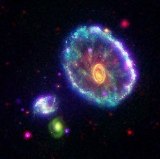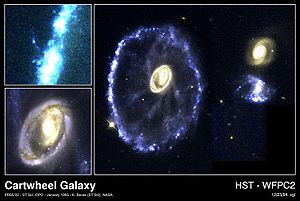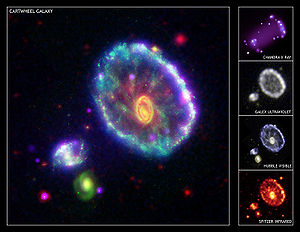
Cartwheel Galaxy
Encyclopedia
The Cartwheel Galaxy is a lenticular galaxy
about 500 million
light-year
s away in the constellation
Sculptor
. It is about 150,000 light-years across. The estimated mass is solar mass
es, and it is rotating at .
It was discovered by Fritz Zwicky
in 1941. When it was discovered, Zwicky considered it to be "one of the most complicated structures awaiting its explanation on the basis of stellar dynamics."
An estimation of the galaxy's span resulted in a conclusion of 150,000 light years, which is slightly larger than the Milky Way.
like the Milky Way
before it apparently underwent a head-on collision with a smaller companion approximately 200 million years ago (i.e., 200 million years prior to the image). When the nearby galaxy passed through the Cartwheel Galaxy, the force of the collision caused a powerful shock wave through the galaxy, like a rock being tossed into a sandbed. Moving at high speed, the shock wave swept up gas and dust, creating a starburst around the galaxy's center portion that were unscathed. This explains the bluish ring around the center, brighter portion. It can be seen that the galaxy is beginning to retake the form of a normal spiral galaxy
, with arms spreading out from a central core
.
 Alternatively, a model based on the gravitational Jeans instability
Alternatively, a model based on the gravitational Jeans instability
of both axisymmetric (radial) and nonaxisymmetric (spiral) small-amplitude gravity perturbations allows an association between growing clumps of matter and the gravitationally unstable axisymmetric and nonaxisymmetric waves which take on the appearance of a ring and spokes.
 The unusual shape of the Cartwheel Galaxy may be due to a collision with a smaller galaxy such as those in the lower left of the image. The most recent star burst (star formation due to compression waves) has lit up the Cartwheel rim, which has a diameter larger than the Milky Way. Star formation via starburst galaxies, such as the Cartwheel Galaxy, results in the formation of large and extremely luminous stars. When massive stars explode as supernovas, they leave behind neutron stars and black holes. Some of these neutron stars and black holes have nearby companion stars, and become powerful sources of X-rays as they pull matter off their companions. The brightest X-ray sources are likely black holes with companion stars, and appear as the white dots that lie along the rim of the X-ray image. The Cartwheel contains an exceptionally large number of these black hole binary X-ray sources, because many massive stars formed in the rim.
The unusual shape of the Cartwheel Galaxy may be due to a collision with a smaller galaxy such as those in the lower left of the image. The most recent star burst (star formation due to compression waves) has lit up the Cartwheel rim, which has a diameter larger than the Milky Way. Star formation via starburst galaxies, such as the Cartwheel Galaxy, results in the formation of large and extremely luminous stars. When massive stars explode as supernovas, they leave behind neutron stars and black holes. Some of these neutron stars and black holes have nearby companion stars, and become powerful sources of X-rays as they pull matter off their companions. The brightest X-ray sources are likely black holes with companion stars, and appear as the white dots that lie along the rim of the X-ray image. The Cartwheel contains an exceptionally large number of these black hole binary X-ray sources, because many massive stars formed in the rim.
Lenticular galaxy
A lenticular galaxy is a type of galaxy which is intermediate between an elliptical galaxy and a spiral galaxy in galaxy morphological classification schemes. Lenticular galaxies are disk galaxies which have used up or lost most of their interstellar matter and therefore have very little ongoing...
about 500 million
1 E22 m
To help compare different orders of magnitude, this page lists distances starting at 10 Zm .Distances shorter than 10 Zm* 24 Zm — 2.5 million light years — Distance to the Andromeda Galaxy...
light-year
Light-year
A light-year, also light year or lightyear is a unit of length, equal to just under 10 trillion kilometres...
s away in the constellation
Constellation
In modern astronomy, a constellation is an internationally defined area of the celestial sphere. These areas are grouped around asterisms, patterns formed by prominent stars within apparent proximity to one another on Earth's night sky....
Sculptor
Sculptor (constellation)
Sculptor is a small and faint constellation in the southern sky. It represents a sculptor. It was introduced by Nicolas Louis de Lacaille in the 18th century. He originally named it Apparatus Sculptoris , but the name was later shortened.-Notable features:No stars brighter than 3rd magnitude are...
. It is about 150,000 light-years across. The estimated mass is solar mass
Solar mass
The solar mass , , is a standard unit of mass in astronomy, used to indicate the masses of other stars and galaxies...
es, and it is rotating at .
It was discovered by Fritz Zwicky
Fritz Zwicky
Fritz Zwicky was a Swiss astronomer. He worked most of his life at the California Institute of Technology in the United States of America, where he made many important contributions in theoretical and observational astronomy.- Biography :Fritz Zwicky was born in Varna, Bulgaria to a Swiss father....
in 1941. When it was discovered, Zwicky considered it to be "one of the most complicated structures awaiting its explanation on the basis of stellar dynamics."
An estimation of the galaxy's span resulted in a conclusion of 150,000 light years, which is slightly larger than the Milky Way.
Structures
The Cartwheel galaxy shows non-thermal radio and optical spokes, but they are not the same spokes.Evolution
The galaxy was once a normal spiral galaxySpiral galaxy
A spiral galaxy is a certain kind of galaxy originally described by Edwin Hubble in his 1936 work The Realm of the Nebulae and, as such, forms part of the Hubble sequence. Spiral galaxies consist of a flat, rotating disk containing stars, gas and dust, and a central concentration of stars known as...
like the Milky Way
Milky Way
The Milky Way is the galaxy that contains the Solar System. This name derives from its appearance as a dim un-resolved "milky" glowing band arching across the night sky...
before it apparently underwent a head-on collision with a smaller companion approximately 200 million years ago (i.e., 200 million years prior to the image). When the nearby galaxy passed through the Cartwheel Galaxy, the force of the collision caused a powerful shock wave through the galaxy, like a rock being tossed into a sandbed. Moving at high speed, the shock wave swept up gas and dust, creating a starburst around the galaxy's center portion that were unscathed. This explains the bluish ring around the center, brighter portion. It can be seen that the galaxy is beginning to retake the form of a normal spiral galaxy
Spiral galaxy
A spiral galaxy is a certain kind of galaxy originally described by Edwin Hubble in his 1936 work The Realm of the Nebulae and, as such, forms part of the Hubble sequence. Spiral galaxies consist of a flat, rotating disk containing stars, gas and dust, and a central concentration of stars known as...
, with arms spreading out from a central core
Core
- Science and Academics :* Core , in mathematics, an object in group theory* Core , in mathematics, a subset of the domain of a closable operator* Core , in mathematics, the homomorphically minimal subgraph of a graph...
.

Jeans instability
In physics, the Jeans instability causes the collapse of interstellar gas clouds and subsequent star formation. It occurs when the internal gas pressure is not strong enough to prevent gravitational collapse of a region filled with matter...
of both axisymmetric (radial) and nonaxisymmetric (spiral) small-amplitude gravity perturbations allows an association between growing clumps of matter and the gravitationally unstable axisymmetric and nonaxisymmetric waves which take on the appearance of a ring and spokes.
X-ray sources


